Characteristics
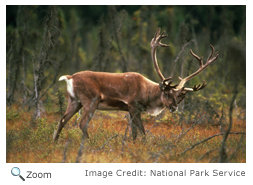 The caribou is a member of the cervid, or deer family. It has brown shaggy fur and a white neck, rump, and belly. In some areas, the caribou can be almost entirely white. The caribou has a long snout; a short tail; and long legs with large, round hooves. The caribou has a dewlap covered with long white hair on its throat. The caribou is a member of the cervid, or deer family. It has brown shaggy fur and a white neck, rump, and belly. In some areas, the caribou can be almost entirely white. The caribou has a long snout; a short tail; and long legs with large, round hooves. The caribou has a dewlap covered with long white hair on its throat.
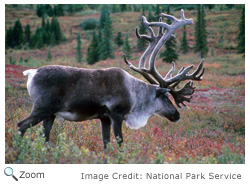 The caribou is the only deer species in which both the male and female have antlers. The male's antlers are large and branch out. The female's antlers are smaller and straighter. The caribou has double layered fur. It has a guard, or outer coat of straight, tubular fur and a woolly undercoat. Male caribou weigh 275-660 pounds; females weigh 50-300 pounds. The caribou is 4-7 feet in length. The caribou is the only deer species in which both the male and female have antlers. The male's antlers are large and branch out. The female's antlers are smaller and straighter. The caribou has double layered fur. It has a guard, or outer coat of straight, tubular fur and a woolly undercoat. Male caribou weigh 275-660 pounds; females weigh 50-300 pounds. The caribou is 4-7 feet in length.
Range
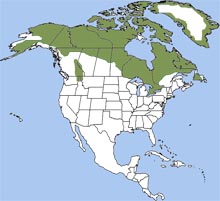 The caribou is found in Alaska and in Canada south through British Columbia to eastern Washington. northern Idaho, and northwestern Montana. It is also found across the northern regions of Europe and Asia, where it is known as the reindeer. The caribou is found in Alaska and in Canada south through British Columbia to eastern Washington. northern Idaho, and northwestern Montana. It is also found across the northern regions of Europe and Asia, where it is known as the reindeer.
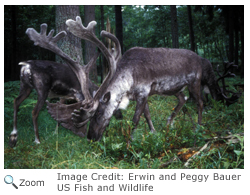 A subspecies, the woodland caribou (Rangifer tarandus caribou), is currently listed as endangered in the U.S. The woodland caribou is a subspecies of caribou found in Montana, Idaho, and Washington. It was once found in New England. A subspecies, the woodland caribou (Rangifer tarandus caribou), is currently listed as endangered in the U.S. The woodland caribou is a subspecies of caribou found in Montana, Idaho, and Washington. It was once found in New England.
Habitat
The caribou is found on the tundra and taiga.
Diet
The caribou eats lichens, mushrooms, grasses, sedges,
flowering tundra plants, the twigs of birches and willows and fruit. |
|
Life Cycle
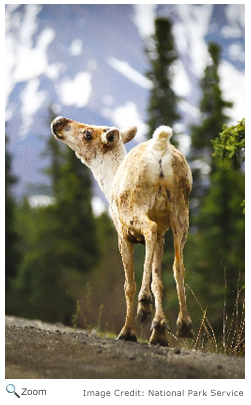 Male caribou compete with each other for females and will sometimes fight using their antlers. They will chase after a female and thrash their antlers in bushes. A male caribou may have a harem of 5-15 females. Mating season runs from October-November. The female gives birth to one or two calves 7-8 months after mating. Calves weigh about 10 pounds at birth and can stand on their own 30 minutes after they are born and will travel with the herd within a day of birth. The calves begin to graze when they are a few weeks old, although they may continue to nurse for a month or so. Calves are independent by the fall. Male caribou compete with each other for females and will sometimes fight using their antlers. They will chase after a female and thrash their antlers in bushes. A male caribou may have a harem of 5-15 females. Mating season runs from October-November. The female gives birth to one or two calves 7-8 months after mating. Calves weigh about 10 pounds at birth and can stand on their own 30 minutes after they are born and will travel with the herd within a day of birth. The calves begin to graze when they are a few weeks old, although they may continue to nurse for a month or so. Calves are independent by the fall.
Behavior
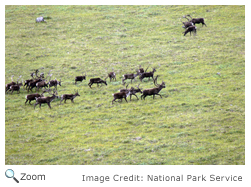 Caribou are nomadic, they are constantly moving in search of food. When they are migrating in the spring, they can travel in huge herds of thousands of animals. Caribou can travel thousands of miles every year. Caribou are nomadic, they are constantly moving in search of food. When they are migrating in the spring, they can travel in huge herds of thousands of animals. Caribou can travel thousands of miles every year.
 Caribou can run at speeds of up to 50 miles per hour. In the summer, their foot pads are soft to help them walk on soggy summer tundra. In the winter, their foot pads shrink, harden and are covered with fur to help them move on the snow and ice. The caribou is a good swimmer and can swim at speeds of up to 6 miles per hour. Caribou can run at speeds of up to 50 miles per hour. In the summer, their foot pads are soft to help them walk on soggy summer tundra. In the winter, their foot pads shrink, harden and are covered with fur to help them move on the snow and ice. The caribou is a good swimmer and can swim at speeds of up to 6 miles per hour.
Video Credit: US Fish and Wildlife
|